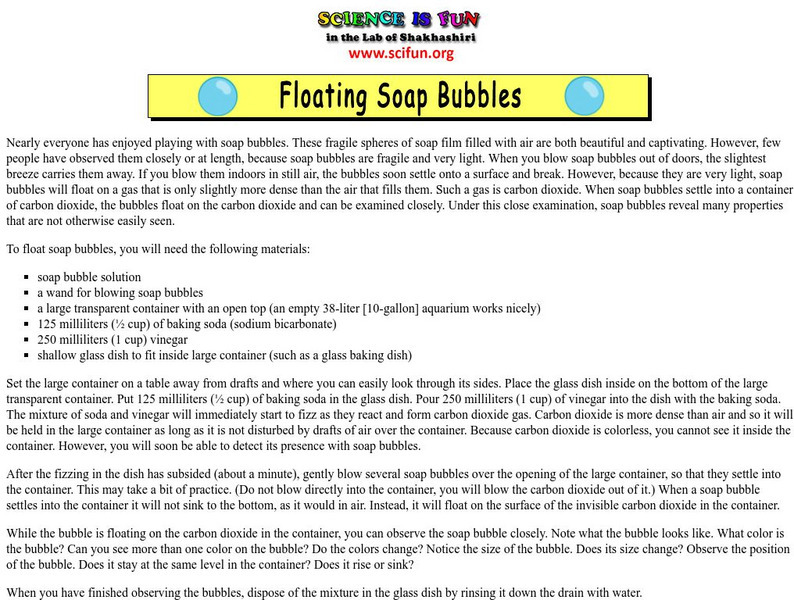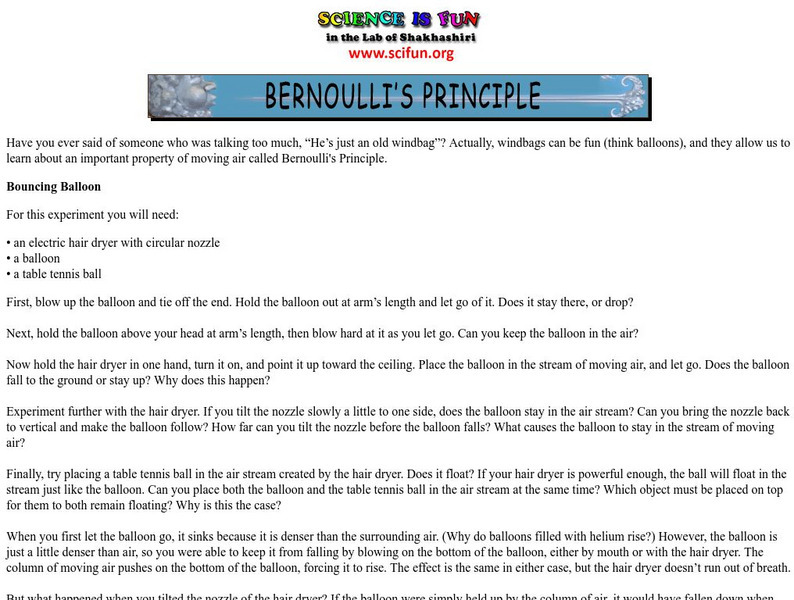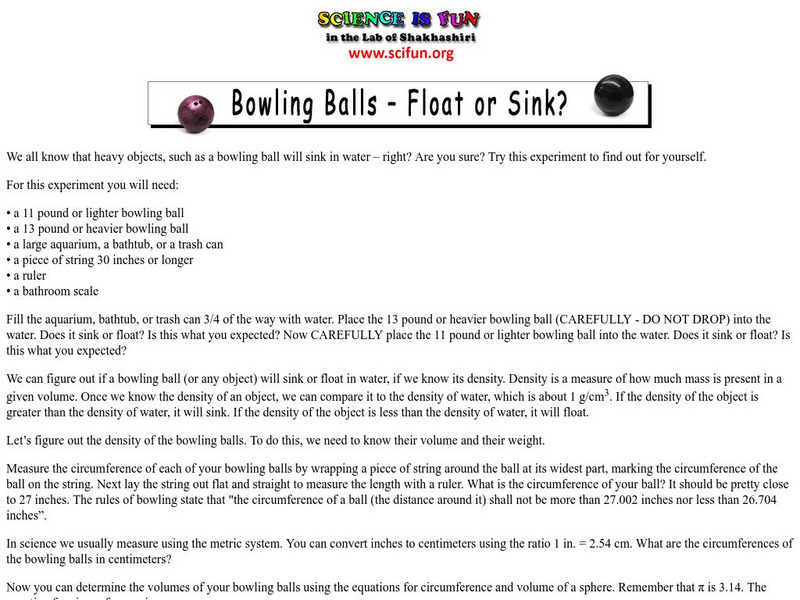Hi, what do you want to do?
Exploratorium
Exploratorium: Science Snacks: Pie Pan Convection
In this experiment, students observe what happens when a pan of soapy, colored water is heated. They will see that convection currents cause the fluid to rise and sink in a localized convection cell.
Exploratorium
Exploratorium: Science Snacks: Hand Held Heat Engine
Can you defy the force of gravity by making liquid in a toy rise and fall without turning it over? This experiment will show you how to use hand boiler that uses temperature and pressure to move liquid into the top chamber.
PBS
Pbs Kids: Dragonfly Tv: Know How? Cutting a Rock
How can you cut a rock without a saw? Is it possible? PBS site invites you to come along with Mike and Victor to find out.
Science Bob Pflugfelder
Science Bob: Build a Hovercraft You Can Ride
Science Bob provides instructions for building a hovercraft you can ride using common supplies with tips for using it.
Other
Port Discovery Children's Museum: Stem at Home: Bouncy Egg Experiment
Would you believe us if we told you we could make an egg bounce without breaking? Check out this experiment. It requires just three ingredients and five easy steps to learn how to bounce an egg.
Ministerio de Educacion, Cultura y Deporte (Spain)
Ministerio De Educacion Y Ciencia: Primer Ciclo Eso
These are 10 different Physics and Chemistry experiments. Each one contains an interactive activity and an evaluation.
Ministerio de Educacion, Cultura y Deporte (Spain)
Elmol: Segundo Ciclo Eso
These are 14 different Physics and Chemistry experiments. Each one contains an interactive activity and an evaluation.
Ministerio de Educacion, Cultura y Deporte (Spain)
Elmol: Bachillerato
These are 14 different Physics and Chemistry experiments. Each one contains an interactive activity and an evaluation.
American Museum of Natural History
American Museum of Natural History: O Logy: Stuff to Do: Dna in a Blender
Follow these illustrated instructions to conduct a simple experiment in separating DNA from an onion!
Discovery Education
Discovery Education: Science of Everyday Life: How Strong Is It? [Pdf]
For this lesson plan students will learn how strong a Post-it notes adhesion really is! Students will experiment pulling a Post-It note to collect quantitative data to explore the adhesive properties of the note.
Science is Fun
Science Is Fun: Candy Chromatography
In this experiment, you learn about chromatography when you separate the dyes in candies like M & M's and Skittles to see how many dyes are in each color.
Science is Fun
Science Is Fun: Floating Soap Bubbles
In this experiment you learn how to generate carbon dioxide inside a container, and float soap bubbles above the gas. Once the bubbles are suspended, it is possible to observe them closely, which is normally very difficult to do....
Science is Fun
Science Is Fun: Chemiluminescence Cool Light
An experiment in chemiluminescent reactions using a commercial Lightstick. As the temperature conditions are changed, students observe changes in the Lightstick and record their observations.
Science is Fun
Science Is Fun: Bernoulli's Principle
An experiment with a balloon and a wind tube that investigate how Bernoulli's Principle applies to a stream of moving air.
Science is Fun
Science Is Fun: Rubber Bands and Heat
An experiment to investigate the thermal properties of rubber by studying its behavior in different scenarios. A discussion of how entropy explains what is observed is provided.
Science is Fun
Science Is Fun: Making Things Glow in the Dark
Try this experiment to learn how to make things glow under a black light, why this happens, and some applications of this phenomenon.
Science is Fun
Science Is Fun: Lumpy Liquids and Squishy Solids
An experiment in viscosity using cornstarch and water. Includes a detailed explanation of viscosity, of Newtonian and non-Newtonian fluids, and examples of different fluids that fit into each category.
Science is Fun
Science Is Fun: Bending Water
An experiment where static electricity is used to 'bend' a stream of water flowing from a faucet. Includes a detailed explanation of how this works.
Science is Fun
Science Is Fun: Conducting Solutions
An experiment where one must first build a conductivity tester, then use it to test how well water conducts electricity when different materials found around the home are each dissolved in it.
Science is Fun
Science Is Fun: Bowling Balls Float or Sink?
In this experiment, you test whether two different bowling balls will float or sink, then determine the density of each of the balls to see if they are less than that of water.
PBS
Pbs Kids: Dragonfly Tv Science Fair: Plan
So, you've chosen your topic and done your research, now, you need to plan your investigation. PBS site walks you through some steps to help guide you through the planning process.
Other
Fun Science Gallery: How to Extract Dna From Fruits
Detailed directions for experiment that allows you to extract DNA from a banana or other fruits or vegetables.
Other
Science Fair Primer
An experienced science teacher shares detailed information regarding how students develop science fair projects. In addition to the key steps involved in working through a project, you will find judging guidelines and links to other...
Science Bob Pflugfelder
Science Bob: Bend a Bone With Vinegar
Use this experiment to show how vinegar reacts with the calcium in a chicken bone.
Other popular searches
- Life Science Experiments
- Egg Science Experiments
- Hands on Science Experiments
- Space Science Experiments
- Food Science Experiments
- 5 Minute Science Experiments
- Simple Science Experiments
- Air Science Experiments
- Fun Science Experiments
- Earth Science Experiments
- Science Experiments Units
- Sea Life Science Experiments

























